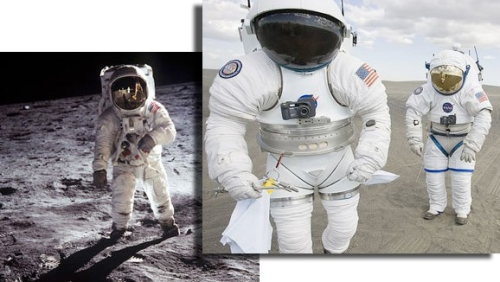 PopSci has a great article about scientists who are trying to recreate the events of the Universe, such as the big bang and black holes, with controlled lab experiments. The Universe in a Teacup, shown above, cools Helium to 0.0003В°F above absolute zero, and moves around the particles so that little whirlpools remain after the Helium settles. The state inside this pinky-sized tube is thought to be the condition of the universe just after the big bang.Scientists also believe that when two large, planar bodies, referred to as branes, collide in the universe, they release enough energy to create a rapid expansion that can spawn a new universe (see explanatory gallery here).
PopSci has a great article about scientists who are trying to recreate the events of the Universe, such as the big bang and black holes, with controlled lab experiments. The Universe in a Teacup, shown above, cools Helium to 0.0003В°F above absolute zero, and moves around the particles so that little whirlpools remain after the Helium settles. The state inside this pinky-sized tube is thought to be the condition of the universe just after the big bang.Scientists also believe that when two large, planar bodies, referred to as branes, collide in the universe, they release enough energy to create a rapid expansion that can spawn a new universe (see explanatory gallery here).
While they can recreate scenarios they believe to be the same as these events, the lack of monitoring tech available makes it impossible to verify. The list of mysteries and theories that scientists have attacked over the last few years makes this an interesting read for fans of Hawking-esque space thinking. [PopSci]
[ Via: Gizmodo, The Gadget Blog ]
[ Tag: ]
Does This Finger Sized Tube Carry The Secrets of the Big Bang? [Big Bang Theory]
NASA Wants to Get You in Bed for $17,000 [Siestas]
NASA wants to get you in bed, and if that wasn't luring enough, she wants to pay you $17,000 for 90 days. Sadly, there is no french lingerie involved: their Bed Rest Project wants to study the effect of long-term microgravity in humans, putting you in a sightly-tilted bed, with your head down and feet up:
Participants will live in a special research unit for the entire study and be fed a carefully controlled diet. After the first 11-15-day period, participants will spend 90 days lying in bed, (except for limited times for specific tests) with their body slightly tilted downward (head down, feet up). Every day, they will be awake for 16 hours and lights out (asleep) for 8 hours. During the bed rest time they will also take part in a number of tests to find out changes in the state of their bone, muscle, heart and circulatory system, and nervous system, as well as their nutritional condition and their ability to fight off infections.In other words: like blogging, but even more boring.And yes, knowing that this is the closer I will get to the space program, I've already signed in. [NASA via Wired—Thanks discounteggroll]
[ Via: Gizmodo, The Gadget Blog ]
[ Tag: ]
High-Res Mars Photographs are Absolutely Stunning [Space]

The Big Picture, my favorite new blog to come around in ages, has 17 of the most remarkable high res images from Mars you're likely to see. It includes everything from detailed photos of the surface to photos from above to animations of dust devils, and you've really got to see it. Above is a high-res pic of the Pheonix lander taken about a week ago, where you can clearly see its arm scooping up Martian dirt for analysis. Amazing. Be sure to follow the link to see the other 12 pictures. [The Big Picture]
[ Via: Gizmodo, The Gadget Blog ]
[ Tag: ]
750,000-Brick Kennedy Space Center Is the Mother of All Lego Models [Giz Goes To Lego]
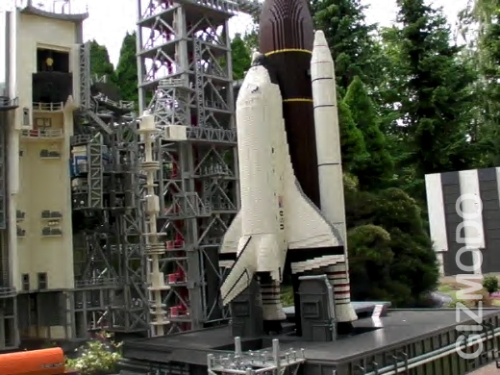
Forget about the Lego Airbus A380 and the Lego Death Star, because this video will show you the mother of all Lego models: the 750,000-brick Kennedy Space Center. Using 1,506 square feet, it took 2,500 hours to build. It includes a 6.13ft-tall Space Shuttle on the launch pad, the space center with a 9ft-long Saturn 1B rocket, and the Vehicle Assembly Building—8ft long x 6ft high x 5ft wide—made out of 50,000 Lego bricks. I know. Mindblowing. This thing is so massive that it can probably affect Earth's orbit. Update: if Lego's Kennedy Space Center is the mother of all Lego models, Giz reader Florian Frischmuth has sent us his pictures of the father: the 1,300,000-brick Lego Allianz Arena stadium in Munich, Germany. This titan contains a mindblowing 30,000 mini-figs inside. The Allianz Arena Lego model was built following the original plans from Swiss architects Herzog and de Meuron, using 4,209 hours of work and over a million pieces. It can glow red, blue, and white using interior LEDs, achieving the same lighting effects of the original stadium thanks to a special translucent brick specially manufactured for the project. [Giz's Lego Trip]
[ Via: Gizmodo, The Gadget Blog ]
[ Tag: ]
SpaceShipTwo Spied, May Turn Out to Be A Private Space Turtle [SpaceShipTwo]

Flightglobal has a picture of what looks like the cockpit for Virgin Galactic's SpaceShipTwo, the successor to (you guessed it!) SpaceShipOne, which successfully completed the first private manned flight into space. Like the SpaceShipOne, it is being built by Scaled Composites in Mojave, CA, where these shots were taken. The picture might not seem like much to look at, but it represents a tangible step towards the era of low earth orbit booze-cruises, which I believe to be historically notable. Full wingered analysis at [Flightglobal Hyperbola].
[ Via: Gizmodo, The Gadget Blog ]
[ Tag: ]
Most Powerful Visualization System Ever Is Faster than 600 Consoles [Hyperwall-2]

What you see here is not a simple array of LCD displays. This is NASA's hyperwall-2, the world's highest resolution visualization system. At 23 by 10 feet wide, hyperwall-2 uses 128 screens driven by 128 graphic processing units with a total of 1,024 processor cores capable of displaying quarter billion-pixel graphics. That's 74 teraflops of power—the number-crunching capacity of six hundred last-generation consoles— accessing 475 terabytes of dat, what scientists and Led Zeppelin technically classify as "a whooping whole lotta love." Instead of gaming, however, this massive display will be used for more mundane things like, you know, black holes or saving lives. NASA says that this system will be key to visually analyze massive data sets. These goes from peeking at black hole collisions to studying global weather patterns, and the design of the new vehicles needed for future manned space programs, as well as assisting in the safety of existing ones. Using hyperwall-2, NASA engineers will be able to analyze re-entries for the space shuttle.
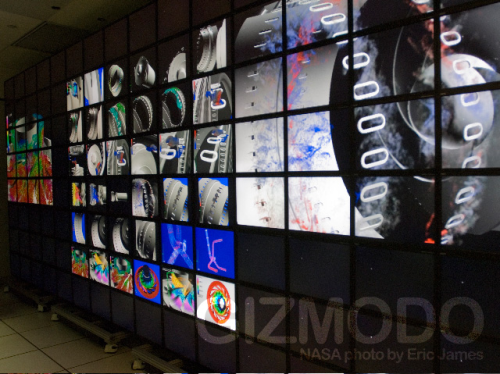
NASA Develops World's Highest Resolution Visualization System[NASA] Really, this is so amazingly cool that it requires a whole lotta of equally cool music.
MOFFETT FIELD, Calif. The power to visualize highly complex information in a way that's easier for the human mind to grasp is taking a giant leap forward with the advent of NASA's new hyperwall-2 system unveiled today at Ames Research Center. Developed by scientists and engineers in the NASA Advanced Supercomputing (NAS) Division at Ames, the 128-screen hyperwall-2, capable of rendering one quarter billion pixel graphics, is the world's highest resolution scientific visualization and data exploration environment. The new tool enables scientists to quickly explore datasets that otherwise would take many years to analyze. The 23-foot-wide by 10-foot tall liquid crystal display wall is being used to view, analyze, and communicate results from NASA's high-fidelity modeling and simulation projects supporting the safety of new space exploration vehicle designs, atmospheric re-entry analysis for the space shuttle, earthquakes, climate change, global weather and black hole collisions. "The hyperwall-2 offers a supercomputer-scale environment that is truly up to the task of visualization and exploration of the very large datasets routinely produced by NASA supercomputers and instruments," said Bryan Biegel, NAS deputy chief. "The system also will be used to get highly detailed information on how NAS supercomputers are operating, enabling staff to quickly and precisely diagnose problems or inefficiencies with the supercomputers or the software running on them." Designed and developed by the NAS visualization team in partnership with Colfax International, Sunnyvale, Calif., the system is powered by 128 graphics processing units and 1,024 processor cores, with 74 teraflops (one teraflop equals one trillion floating point operations per second) of peak processing power and a data storage capacity of 475 terabytes (one terabyte equals one trillion bytes). The hyperwall-2 allows researchers to quickly determine trends across an array of related simulation results, or to view a single large image or animation. It would take nearly 600 video game consoles to equal the hyperwall-2's graphics processing capabilities. "We are proud to continue partnering with NAS as it offers advanced, innovative solutions for high-performance computing," said Gautam Shah, chief executive officer, Colfax International. "As NASA Ames successfully responds to support the visualization and data analysis needs of researchers to maximize the understanding of scientific results, Colfax International is pleased to be part of the hyperwall-2 visualization cluster project," Shah added. Colfax previously built a "mini" hyperwall for NAS used for demonstrations at national conferences. With a direct, high-speed connection from the supercomputers at NAS, including the Columbia supercomputer, hyperwall-2 will enable NASA to meet its increasing needs for advanced visualization and analysis of large, high-dimensional simulation results. With more than 100 times the processing power of the original 49-screen hyperwall developed in 2002 by the NAS visualization team, hyperwall-2 will be integrated with the team's software tools. This includes a state-of-the-art concurrent visualization framework to provide NASA scientists and engineers with ultra-high resolution images and videos to explore results of their research and analysis.
God bless Dread Zeppelin, Robert Plant's favorite cover band*. * Yes. It's a fact. Led Zeppelin + Reggae + Elvis = WIN.
[ Via: Gizmodo, The Gadget Blog ]
[ Tag: ]
Video of the Moon Passing in Front of the Earth Taken From 31 Million Miles Away [Space]
We don't have too many cameras out there in space past the moon, which is why most of our space shots are either looking outward, such as the shots taken by Hubble, or taken of Earth from the moon or closer. Which is why this video is so astounding. It's a video of the moon passing directly in front of the Earth, taken by NASA's EPOXI spacecraft from a whopping 31 million miles away.
The quality isn't the best, but it doesn't need to be; it's still absolutely breathtaking. This is an alien's-eye view, my friends, seen for the very first time. Amazing. [Bad Astronomy via Neatorama]
[ Via: Gizmodo, The Gadget Blog ]
[ Tag: ]
THEMIS Satellites Discover Northern Lights Are Powered By Magnetic Fields Snapping Like Rubber Bands [Nasa]

Five NASA satellites from the THEMIS mission were recently able to closely witness the chain of events that occurs to create the northern lights for the first time. Complex stuff going on here, but it involves the Earth's massive electromagnetic fields being stretched to their limits by magnetic bombardment from the sun, and then snapping back into place like giant rubber bands, all of which the five THEMIS birds were able to witness at precisely the right moment. Awesome. "Explosions of magnetic energy a third of the way to the moon," says NASA, "power substorms that cause sudden brightenings and rapid movements of the aurora borealis...We discovered what makes the Northern Lights dance." The process is called magnetic reconnection (check back to that incredible video of visible magnetic field lines for a general idea) and when we're talking about the fields generated by the whole Earth, it involves a lot of energy. When the fields snap around like rubber bands, charged particles collide with atmospheric gasses and release visible light energy, and boom, aurora borealis:

NASA Satellites Discover What Powers Northern Lights GREENBELT, Md. — Researchers using a fleet of five NASA satellites have discovered that explosions of magnetic energy a third of the way to the moon power substorms that cause sudden brightenings and rapid movements of the aurora borealis, called the Northern Lights.
The culprit turns out to be magnetic reconnection, a common process that occurs throughout the universe when stressed magnetic field lines suddenly snap to a new shape, like a rubber band that's been stretched too far. "We discovered what makes the Northern Lights dance," said Dr. Vassilis Angelopoulos of the University of California, Los Angeles. Angelopoulos is the principal investigator for the Time History of Events and Macroscale Interactions during Substorms mission, or THEMIS. Substorms produce dynamic changes in the auroral displays seen near Earth's northern and southern magnetic poles, causing a burst of light and movement in the Northern and Southern Lights. Substorms often accompany intense space storms that can disrupt radio communications and global positioning system signals and cause power outages. Solving the mystery of where, when, and how substorms occur will allow scientists to construct more realistic substorm models and better predict a magnetic storm's intensity and effects. "As they capture and store energy from the solar wind, the Earth's magnetic field lines stretch far out into space. Magnetic reconnection releases the energy stored within these stretched magnetic field lines, flinging charged particles back toward the Earth's atmosphere," said David Sibeck, THEMIS project scientist at NASA's Goddard Space Flight Center in Greenbelt, Md. "They create halos of shimmering aurora circling the northern and southern poles." Scientists directly observe the beginning of substorms using five THEMIS satellites and a network of 20 ground observatories located throughout Canada and Alaska. Launched in February 2007, the five identical satellites line up once every four days along the equator and take observations synchronized with the ground observatories. Each ground station uses a magnetometer and a camera pointed upward to determine where and when an auroral substorm will begin. Instruments measure the auroral light from particles flowing along Earth's magnetic field and the electrical currents these particles generate. During each alignment, the satellites capture data that allow scientists to precisely pinpoint where, when, and how substorms measured on the ground develop in space. On Feb. 26, 2008, during one such THEMIS lineup, the satellites observed an isolated substorm begin in space, while the ground-based observatories recorded the intense auroral brightening and space currents over North America. These observations confirm for the first time that magnetic reconnection triggers the onset of substorms. The discovery supports the reconnection model of substorms, which asserts a substorm starting to occur follows a particular pattern. This pattern consists of a period of reconnection, followed by rapid auroral brightening and rapid expansion of the aurora toward the poles. This culminates in a redistribution of the electrical currents flowing in space around Earth. THEMIS is the fifth medium-class mission under NASA's Explorer Program. The program, managed by the Explorers Program Office at Goddard provides frequent flight opportunities for world-class space investigations in heliophysics and astrophysics. The University of California, Berkeley's Space Sciences Laboratory in Berkeley, Calif., managed the project development and is currently operating the THEMIS mission. ATK Space (formerly Swales Aerospace) of Beltsville, Md., built the THEMIS satellites. The THEMIS team's findings will appear online July 24 in Science Express and Aug. 14 in the journal science. For more information about the THEMIS mission, visit: http://www.nasa.gov/themis
[ Via: Gizmodo, The Gadget Blog ]
[ Tag: ]
NASA's First Solar-Sail Powered Craft Set to Ride on a Stream of Photons Next Week [Come Sail Away]
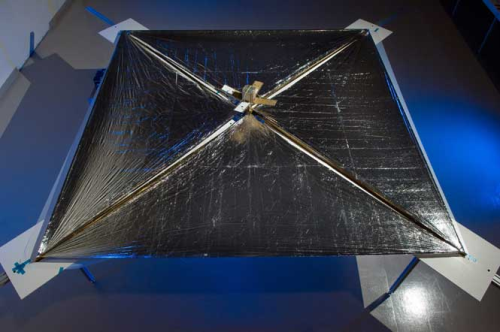
NASA's getting set to launch the NanoSail-D next week, its first solar-sail powered spacecraft which catches photons like wind on a 10 square-meter sail made of a thin metallic polymer. The craft uses a crazy Rube Goldberg-like method to deploy the sail that involves burning fishing line at critical moments to release the spring-loaded sail, which is getting shown off in the video here.
It is hoped that sails many times larger (we're talking football fields) will eventually propel long-range missions into deep space, with the help of lasers here on Earth firing light into their sails. The NanoSail-D is sticking in near-Earth orbit to perform its tests, which will inform later uses of the tech. One caveat is that the launch is scheduled for July 29 aboard a SpaceX Falcon 1 rocket, which like to go ka-boom and have yet to deliver a payload into orbit successfully. Our fingers are crossed for the little sailor. [Technology Review]
[ Via: Gizmodo, The Gadget Blog ]
[ Tag: ]
NASA Shows Off Fireworks In Space [July 4th]
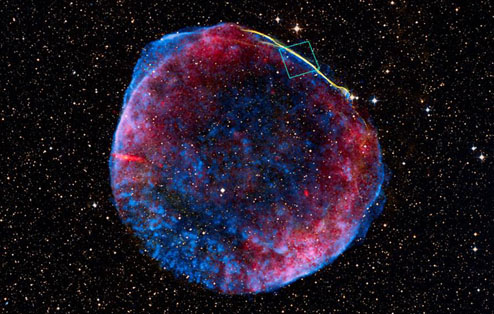
Before we completely bid adieu to our nation's birthday, we here at Gizmodo would like to give one more shout out to the fourth of July. Seems like even the stars in the sky can't resist putting up a display for good ol' American freedom. These red-white-and-blue pictures of Supernova remnant SN 1006 are what's left over from a star explosion first observed by humans in year 1006. The flash in the sky is a remnant of a blast 7,000 light-years away in the Lupus constellation. Scientists say that it was the brightest observed supernova in recorded history, and that the light from the explosion could be seen in the daytime for weeks afterward. The supernova sent a shockwave that traveled outwards at nearly 20 million mph. In the 1960s, radio astronomers first detected the ring of material pushed out by the shockwave. With the latest imagery, released by the Hubble Space Telescope's science team, you can see a gossamer stripe with starlight shining through it – the rocket's red glare indeed.

[ Via: Gizmodo, The Gadget Blog ]
[ Tag: ]
NASA Points to the Sky Tonight For a Different Celebration [Space]

In your daily dose of science geekiness, you may appreciate another event going on in the sky this July 4th than the annual combustion of your neighbor's illegal stash of gunpowder—Mars and Saturn will align for the evening. Then on the 5th, the Moon will join those two for a little celestial ménage à trois. We know, it's usually too much work to grab your telescope for these things. But since you'll be staring at the sky already... [NASA via TFOT, Image]
[ Via: Gizmodo, The Gadget Blog ]
[ Tag: ]
Help Save the Arecibo Observatory: ET Is Counting on You [Aliens]

The Arecibo Observatory has been plagued with budget problems for years now, but it appears that the future of the world's largest radio telescope is looking bleaker than ever with cuts looming that could shut down the project for good. That grim reality has prompted the guys behind SETI@home to call out to the public in a last ditch attempt to secure donations and support for the Senate bill and House resolution to continue funding. With our luck, E.T. will try and make contact the day the observatory goes offline, so hit the following link and show your support. [Seti@home]
[ Via: Gizmodo, The Gadget Blog ]
[ Tag: ]
Micro Satellites Geared Toward Private Sector Make Tin Foil Hats a Good Idea [Satellites]
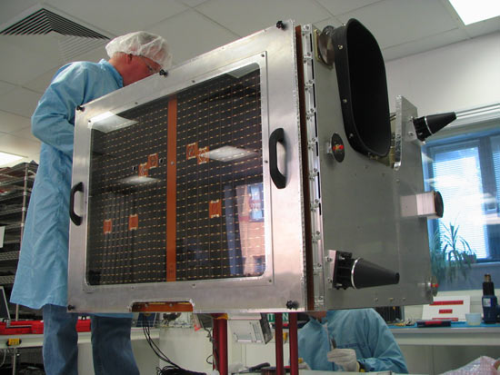
The Guardian wrote a neat feature on Surrey Satellite Technologies, who are currently working on scaled down, fully functional satellites for commercial consumption that only cost 10 million dollars, only weigh 220 pounds, and only take 18 months to build. But when compared to full-sized satellites ($500m, 1000 kg) used by government agencies and large corporations, these micro-satellites are amazingly compact and cost effective. Surrey will be sending 5 of these into orbit on the back of an old soviet rocket in Kazhakstan. The "diminutive" satellite will be able to take photos for various applications, like surveying natural disasters, evaluating agricultural fraud, so on and so forth. However, the paranoid schizophrenic in me thinks it's really going to be used for personal world domination. [The Guardian via John Dvorak via Gizmo Watch via Dvice]
[ Via: Gizmodo, The Gadget Blog ]
[ Tag: ]
New Dish Network Satellite Launched, More HD Channels On the Way [Satellite]

In order to offer more HD channels, satellite providers need more satellites. So happy day for Dish Network subscribers, their EchoStar XI satellite was successfully launched this morning after a satellite propelled into space last March didn't reach the right orbit. This'll let Dish add 17 new HD channels shortly, bringing them up to 100. DirecTV says they'll have over 150 by the end of the year, though Dish's upcoming all-HD TurboHD package could wind up being a better deal if history is any guide. [Reuters]
[ Via: Gizmodo, The Gadget Blog ]
[ Tag: ]
NASA Collecting 8 Gallons of Employees' Urine Daily For Space Toilet Research [Yuck]

NASA workers at the Johnson Space Center in Houston received what may be the high point in inter-office email last week requesting they begin to pay regular visits to the good folks of Hamilton Sundstrand, aka the "Wee Wee Contractors." They're collecting urine in massive quantities—eight gallons per day—as part of their contract to build the toilet for the upcoming Orion lunar spacecraft. But why do they need so much? I'm sure it's all there in the email... The researchers need this massive amount to try to figure out what to do with all the urine the Orion astronauts will produce over the course of their missions on the lunar surface, which could last as long as six months. Urine is full of solid particles that tend to clog waste venting systems, making it a challenge to dispose of efficiently. And as Jeff Lewis, head of life support for the Orion craft told the AP, "you can't make fake urine." Here's the full email in all its glory:
Sent: Friday, July 11, 2008 3:00 PM Subject: Urine Collection Study Donor Request Who: All Houston-SLS Associates, employees at 2200 Space Park, and any visitors to the building What: Please donate your urine to our study When: Monday, July 21 - Thursday, July 31 from 6 a.m. until goal amount is collected each day including weekends Where: First floor lab Kick-off Meeting: Thursday, July 17 11-11:30 am in the first floor conference room SLS-Houston Associates, The Orion Program will be holding a urine collection study starting Monday, July 21 and running through Thursday, July 31, 2008. We are looking for donors as we need to collect a large amount of urine per day for the entire 11 day period. Please contact [deleted] at [deleted]@hs.utc.com to express interest in donating or to get answers to any questions you have regarding the study. We will be hosting an informational meeting with encouraged attendance for potential urine donors from 11-11:30 a.m. Thursday, July 17, 2008 in the first floor conference room. In this meeting we will go over instructions and guidelines for the study and introduce volunteers to the equipment that will be used in the study. If you are unable to attend this meeting due to scheduling conflicts, we can set up another time to clarify the study operations on an individual basis. Please see the attached Donor Guide for further information on donating. Urine Collection - Donor Guide General Guidelines 1. Do not add urine to the collection that was collected more than 1 hour before addition. This is necessary so that urine is exposed to the pretreatment chemical in a timely manner. 2. Do not add urine with blood in it into the system. This is an issue of personnel safety. 3. Some previous tests have limited donation size to 350mL per donation. While this is not a regulation of our testing, you are not encouraged to over-hydrate as this could dilute the urine we collect. 4. Our test is meant to be as flight-like as possible. This means that unlike in the doctor's office, you do not need to worry about starting collection midstream. Our testing will be more accurate if you collect as much of the entire urination as possible including the beginning. Procedure for donation 1. Donation 1. At work 1. Take a wide mouthed beaker to the bathroom to collect your urine. You may pick up a beaker from the first floor lab in advance. 2. Fill the beaker and take it to the first floor lab to pour it into the collection. 3. Fill out the donation sheet as instructed in step 2. 2. At home 1. If you are collecting urine at home in the morning before coming in to work, remember to take collection beakers and labels home with you. You are welcome to take both a wide mouthed beaker for collection and bottle with a lid for transport. Record the volume of your sample before transferring as the bottles with lids are not marked with volumetric measurements. 2. Once you put the urine into the bottle with a lid, fill out a label or a piece of masking tape with the time of collection and sample volume and stick it on the bottle. 3. Urine older than 1 hour cannot be put into the system, so please keep that in mind when collecting urine at home. We suggest that morning urine be collected at home but not nighttime urine. 2. Fill out the donation sheet with the following information:
1. Time of sample collection
2. Time of addition to the system
3. Volume 1. Measure donation volume while it is in the wide mouthed beaker, before pouring it into the bottle with a lid 4. Your donor number
1. A donor number will be assigned to you so that we can keep track of donations without listing names
[ Via: Gizmodo, The Gadget Blog ]
[ Tag: ]
GPS-Like System Being Developed For Moon Astronauts [Moon Travel]
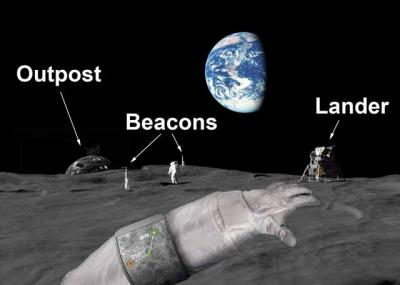
When astronauts finally get back to the moon sometime between now and 2020, they will have an advantage that their predecessors did not—GPS. Well, it's not technically GPS given the fact that there are no satellites orbiting the moon, but the astronauts may not know the difference. The new system being developed by Ohio State researcher Ron Li will "rely on signals from a set of sensors including lunar beacons, stereo cameras, and orbital imaging sensors" to simulate GPS.
Li explained how the system will work: images taken from orbit will combine with images from the surface to create maps of lunar terrain; motion sensors on lunar vehicles and on the astronauts themselves will allow computers to calculate their locations; signals from lunar beacons, the lunar lander, and base stations will give astronauts a picture of their surroundings similar to what drivers see when using a GPS device on Earth. The researchers have named the entire system the Lunar Astronaut Spatial Orientation and Information System (LASOIS)NASA has awarded Li a $1.2 million grant to develop the LASOIS system over the next three years. He hopes that it will help the astronauts explore the lunar surface with a greater degree of confidence and avoid the stress that comes with getting lost. After all, losing your bearings on the moon is a far cry from taking the wrong exit on the highway. [Physorg]
[ Via: Gizmodo, The Gadget Blog ]
[ Tag: ]
Mars Phoenix lander has near-perfect landing, says "it's really cold out here"
Things are looking good for the Phoenix lander which touched down on Mars at 4:53pm on Sunday, May 25. The NASA nerds are reporting an almost perfect landing, with the spacebot tilted only one quarter of a degree. In fact, they're claiming that this landing was "far smoother than any simulation or test that was ever done." The lander's north-pole location is measured at -106 degrees Fahrenheit and chock-full of life-preserving ice. Phoenix will chill on Mars for 90 days, sniffing soil and looking for frozen Martians in whatever form they may take. Now that Mars Oddyssey -- one of its main communication uplinks -- has passed over the lander, we have our first pictures, one of which is above. Nice work, guys!
[ Via: The Phoenix Mission ]
[ Tag: mars, nasa, phoenix, phoenix lander, PhoenixLander, space ]
Mars Phoenix lander to touch down on the red planet tonight
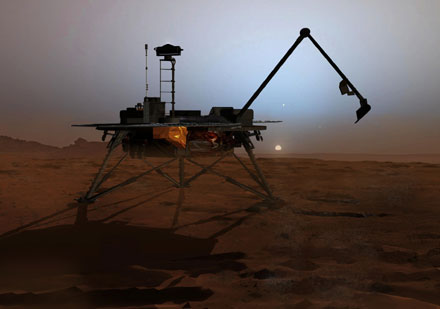
Suit up, space nerds, because the Phoenix lander is mere hours away from touchdown on Mars, and NASA's blowing this thing out. Not only will you get a live video feed from their site, but apparently Mission Control ops will be liveblogging the touchdown and ensuing alien encounters / totally boring rock digging. Festivities kick off at about 6:00pm ET, prepare to set faces to stunned.
[ Via: Engadget ]
[ Tag: mars,nasa,phoenix,phoenix lander,PhoenixLander,space ]
NASA's new suits are one giant leap for space fashion
NASA just awarded its future spacesuit contract to Oceaneering International. The US firm must now design, test, and produce two suits -- the default suit (pictured after the break) worn on-board for launch and landing and a second, more versatile, cheese-proof suit worn during space walks and upon the surface of the moon. The suits must be ready for the first scheduled launch of the Orion Space Capsule in 2015. The contract is valued at the government special price of just $745 million. Hey, we have to keep up appearances at the International Space Station, you know.

[ Via: Engadget ]
[ Tag: moon,nasa,oceaneering international,OceaneeringInternational,orion,spacestation,spacesuit ]
First team sets a date for Google Lunar X-Prize attempt
Just under a year after Google ponied up the money for the Lunar X Prize, there's a team set to attempt a launch and claim the $20M reward. The Aeronautics and Cosmonautics Romanian Association (ARCA) has scheduled up a launch of a 92-pound rover called the European Lunar Lander within the next three months, with the plan being to float a balloon over the sea to a height of 11 miles, at which point a STABILO rocket will carry the payload to space. To win the prize, the ELL has to land, travel 500 feet on the surface of the moon, and send video, images, and data back to Earth. That's quite a tall order -- we'll be watching this one closely, since even if ARCA succeeds, there's still several $5M prizes out there for second places and the completion of several other objectives.
[ Via: Engadget ]
[ Tag: acra, Aeronautics and Cosmonautics Romanian Association, AeronauticsAndCosmonauticsRomanianAssociation, ell, European Lunar Lander, EuropeanLunarLander, google, lunar, lunar x prize, LunarXPrize, space, x prize, XPrize ]
Unmanned Japanese Cargo Spacecraft Could Be NASA's Next Space Shuttle [Space]
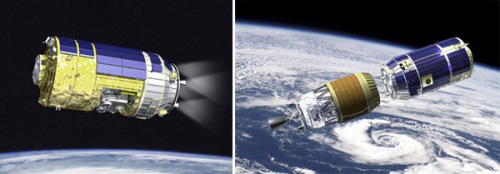
With the dinosaur Space Shuttle set to retire in 2010, and Orion due to be finished (optimistically) by 2015, NASA may purchase the $131 million unmanned HTV cargo vehicle from JAXA, Japan's space agency, to guarantee fresh shipments of space-Doritos flowing up to the brave souls on the International Space Sation. While they had initially planned to fill this gap by relying on commercial space cargo flights by companies like SpaceX, Reuters is reporting that delays in the private-sector space companies have caused NASA to look elsewhere to avoid being crippled by the Shuttle's retirement. UPDATE: NASA issued a statement this afternoon saying the Reuters' report was full of baloney. They're still dedicated to finding commercial haulers—full release below.
Statement on Inaccurate Reports About Japanese Cargo Services WASHINGTON — Contrary to news reports, NASA has not officially or unofficially been discussing the purchase of H-II Transfer Vehicles (HTV) — uninhabited resupply cargo ships for the space station — from the Japanese Space Agency, or JAXA. NASA is committed to domestic commercial cargo resupply to the space station and does not plan to procure cargo delivery services from Japan. As part of our original agreements as compensation for common system operating costs NASA has limited cargo capability on the Japanese and European cargo vehicles. NASA has recently issued a request for proposal for the cargo needs of International Space Station beyond those supplied by our current international agreements. NASA has chosen to depend on commercial resupply of cargo delivery to the station.
[ Via: Gizmodo, The Gadget Blog ]
[ Tag: ]
First Look At New Russian-Euro Lunar Capsule [Spacecraft]

Here it is, fellow space-geeks, the first official image of the new joint Russian-European manned spacecraft, and we'll be damned if it doesn't look like something out of the Ikea Kitchen Collection. It's made to ferry up to four people (cosmonauts or astronauts?) to the moon and back, with a two-stage orbiter-and-lander design much like the original American lunar missions. What's interesting is that the craft uses thrusters to slow its descent to the moon's surface as well as to launch itself off the surface. The Russians state that they expect a launch in 2018, though a launch could happen sooner if stock rockets currently available are modified, which sounds perfectly and totally safe to us. [BBC]
[ Via: Gizmodo, The Gadget Blog ]
[ Tag: ]
UFO crashes in Potters Fields Park as part of Vauxhall promotion
The launch of the next-generation Vectra (or Insignia, as it has become) has been a long time coming, and Vauxhall is making good and sure everyone notices now that its time has arrived. As part of an elaborate marketing scheme, the automaker crashed a UFO in Potters Fields Park in London, and there was even a fence, men in dark glasses that were evidently mute and copious amounts of smoke to set the scene. Just how this relates to a new motorcar? You've got us there.
[ Via: Black-Night-Sky ]
[ Tag: ads,advertisement,advertising,england,Insignia,london,promo,promotion,UFO,uk,Vauxhall,Vectra ]
Moon Base Two Could House Four Astronauts for a Six Month Moon Stay [Space]
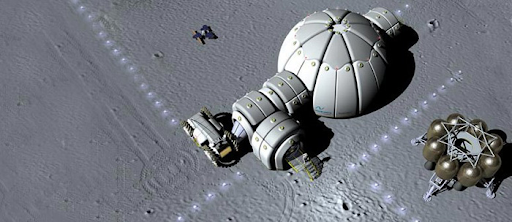
What's the next step in space exploration? A semi-permanent moon base, of course. It's about time we get a settlement up there for astronauts to stay at for months at a time, don't you think? Experimental architecture firm Architecture and Vision does, and they've designed what they've dubbed Moon Base Two, a base that can accommodate astronauts for months at a time.
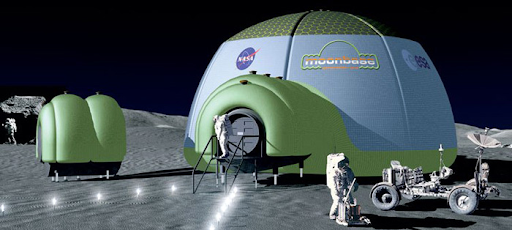
[ Via: Gizmodo, The Gadget Blog ]
[ Tag: ]
Subscribe to:
Comments (Atom)

